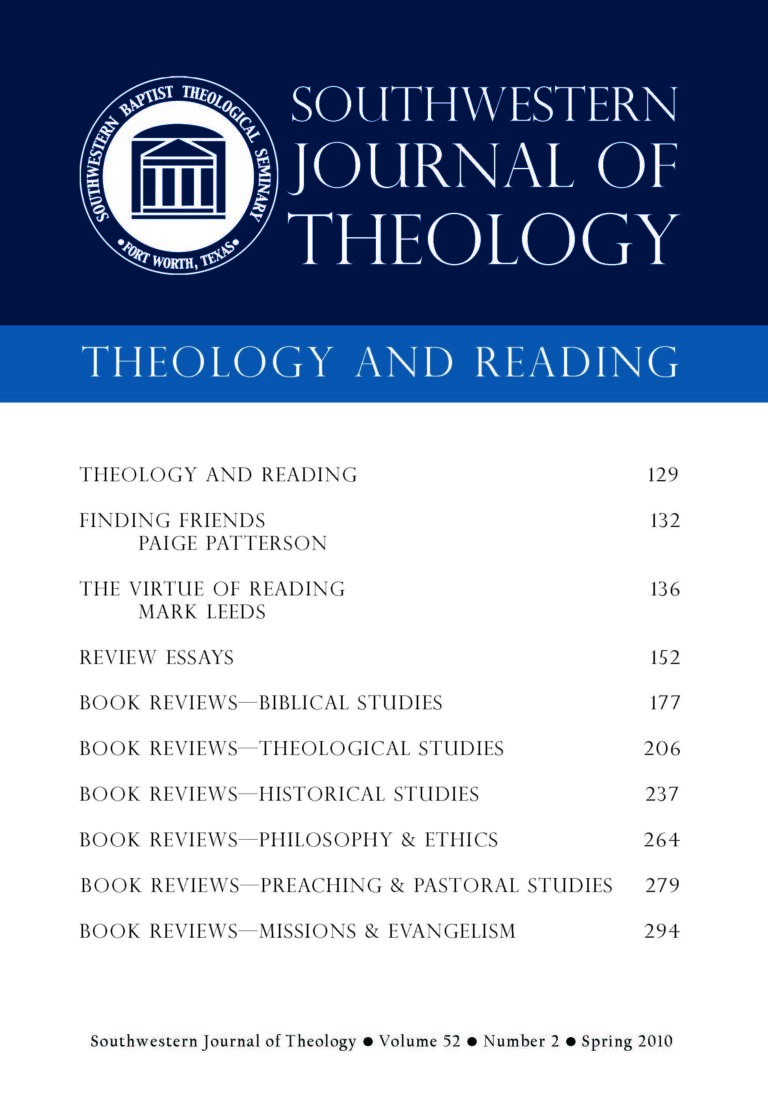
Theology and Reading
Southwestern Journal of Theology
Volume 52, No. 2 – Spring 2010
Managing Editor: Malcolm B. Yarnell III
By Ulrich Luz. Translated by James E. Crouch. Hermeneia. Minneapolis: Fortress, 2007. 432 + xxxviii pages. Hardcover, $75.00.
Ulrich Luz, Protestant Professor Emeritus of New Testament at the University of Bern in Switzerland, is the author or coauthor of a number of books on the Gospel of Matthew including Matthew in History: Interpretation, Influence, and Effects (1994), The Theology of the Gospel of Matthew (1995), and Studies in Matthew (2005). However, he is best known for his multi-volume commentary on Matthew originally published in the German, ecumenical Evangelisch-Katholischer Kommentar zum Neuen Testament series. The book under review is a translation of the fifth German edition of the first volume. Luz revised the volume thoroughly for this edition. Although the basic substance and approach remain unchanged, about one third of its text is completely new, bringing the commentary to more than 2000 pages—probably the most extensive European commentary ever written on Matthew.
The layout and the features of the commentary make it a handy tool to use. The text is neatly arranged in double columns, paragraphs on details are in a smaller font, and a number of subheadings helpfully structure the discussion of each passage. For each passage, Luz provides a helpful and up-to-date bibliography of the important publications listing German and English literature as well as French, Italian, and Spanish works. In addition, the footnotes are packed with helpful statistics, background information, and hints for further reading.
The most distinct quality of the commentary, however, is Luz’s methodological approach and hermeneutical convictions. The author explicitly defines his exegetical approach as a modified historical-critical method. He criticizes classical historic-critical exegesis because it tends to isolate the biblical texts in their own time, making them meaningless for the present. Luz hopes to overcome this weakness by taking into account the texts’ history of interpretation as well as the texts’ history of influence (63). He is convinced that any interpretation and reception throughout history demonstrates the texts’ power; consequently, it is relevant for understanding the texts today. “[B]iblical texts do not simply have a fixed, closed meaning; they are full of possibilities” (64).
The practical consequences of these fundamental convictions are farreaching and observable throughout the commentary. Although Luz begins the analysis of each passage by discussing its structure and presenting its major interpretative questions, his focus is neither on textual issues nor on grammatical, semantic, or syntactic aspects. Instead, he is primarily concerned to reconstruct traditions and redactions, to identify parallels and motives, and to direct attention to each passage’s interpretations (Auslegungsgeschichte) and influences (Wirkungsgeschichte) throughout history. He includes a wide range of parallel material and interpretations—from different expositors and churches (ancient fathers, Eastern Churches, Scholastics, Reformers, Anabaptists, Methodists) to different religions and philosophies (Buddhism, Taoism, Platonism, Stoicism) to different artists and historical figures (Tolstoy, Gandhi, Heine, von Weizsäcker). To be sure, this data is not just presented extensively in order to offer historical facts; rather, Luz takes it as crucial for current exegesis. Because of the “openness of the text(s)” (190, 314; cf. 115, 248, 269), they were rewritten in new situations and therefore gained new sense, which is of equal importance as its original.
The results of this approach are not unproblematic. Although Luz frequently admits the hypothetical character of reconstructions (e.g. 91, 204, 250, 310, 330–31, 340), he regularly determines both the texts’ redactions and the redactors’ motives with astonishing precision (see e.g. 148, 255–59). One wonders how he knows all these details. Moreover, Luz’s gathering of such an impressive range and amount of material has its downside. Mirroring contemporary (European) exegesis, Luz tends to tolerate almost any interpretation, often without deciding in favor of one of them. Correspondingly, the reader should not expect to find applications in the commentary. Luz is convinced that biblical texts need to be newly actualized for every new situation, for “[t]o ask about a ‘true’ interpretation of biblical texts today is to ask about our present situation. Truth is always situational” (269; italics original).
Luz’s commentary represents the best of current liberal exegesis offering extensive source and redaction criticism, but relatively little detailed, philological analysis. Of particular importance is the work’s value as a unique resource concerning the texts’ history of interpretation and history of influence. The commentary is and will be a standard in Matthean studies—although less likely in pulpits—for the years to come.





